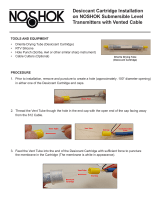
PT-510 Series Pressure Transmitters
Installation Guide
PT-510 and PT-510W
R
APG
Automation Products Group, Inc.
1025 W 1700 N Logan, UT 84321
www.apgsensors.com | phone: 888-525-7300 | email: [email protected]
Thank You
Thanks for purchasing a PT-510 series pressure transmitter from us! We appreciate your business
and your trust. Please take a moment to familiarize yourself with the product and this manual
before installation. If you have any questions, at any time, don’t hesitate to call us at 888-525-7300.
1.Description
2. How To Read Your Label
3. Warranty
4. Mounting Instructions
5. Dimensions
6. Wiring Information
7. Vent Tube Drying
8. General Care
9. Repair Information
10. Removal Instructions
Table of Contents
4
Mounting Instructions
Your PT-510/PT-510W series submersible pressure transducer is designed to be free-hanging.
5
Dimensions
NOTE: Scan the appropriate QR code to the below to see the full user manual on your
tablet or smartphone. Or visit www.apgsensors.com/support to nd it on our website.
PT-510 & PT-510W User Manual
Part # 122950-0038
Doc #9005032 Rev A
Each label comes with a full model number, a part number, and a serial number. The model
number for the PT-510 will look something like this:
The model number correlates with all the congurable options and tells you exactly what you have.
Compare the model number to the options on the datasheet to identify your exact conguration.
You can also call us with the model, part, or the serial number and we can help you.
The label also includes the pinout, as does this installation guide.
SAMPLE: PT-510-C-20-L01-60
PT-510/PT-510W series submersible pressure transmitters oer reliability in harsh industrial
conditions. The small size, and all welded, all stainless steel body make the durable PT-510/PT-
510W the perfect instrument for static and dynamic pressure measurement. The PT-510 comes
with a Delrin nose cone, suitable for clean water use, while the PT-510W has a stainless steel cage
for additional transducer protection in wastewater environments.
1
Description
2
How To Read Your Label
3
Warranty
This product is covered by APG’s waranty to be free from defects in material and workmanship
under normal use and service of the product for 24 months. For a full explanation of our Warranty,
please visit https://www.apgsensors.com/about-us/terms-conditions. Contact Technical Support to
recieve a Return Material Authorization before shipping your product back.
Scan the QR code below to read the full explanation of our Warranty on your tablet or smartphone.
4.7"
[119.8mm]
3.7"
[94.2mm]
1.0"
[25.7mm]
[21.9mm]
ø 0.9"
[18.8mm]
ø 0.7"
ø 0.1"
[2.6mm]
4.8"
[121.4mm]
3.1"
[79.0mm]
1.7"
[42.4mm]
1.0"
[25.4mm]
ø 3.5"
[88.9mm]
ø 3.6"
[91.4mm]
0.4"
[9.4mm]
0.3"
[7.6mm]
ø 0.9"
[21.9mm]

7
Vent Tube Drying
Condensation in the vent tube can damage the electronics in your sensor, resulting in unreliable
readings. APG oers two methods of preventing vent tube condensation: a venting cap and a
desiccant drying cartridge.
The venting cap is a PVC tube with a hydrophobic patch that allows moisture to pass out of the
tube without allowing water in. The cap is sealed by an o-ring, and is easily installed in the eld.
The desiccant drying cartridge with vent tube adapter absorbs any moisture in the vent tube to
keep vapor from condensing. The installation of the desiccant drying cartridge is quick and easy.
Common installation methods are cable tie, Velcro, and cable clamps.
8
General Care
Your pressure transmitter is very low maintenance and will need little care, as long as it was
installed correctly. However, in general, you should:
• Avoid applications for which the sensor was not designed, such as extreme temperatures,
contact with incompatible corrosive chemicals, or other damaging environments.
• Avoid touching the diaphragm. Contact with the diaphragm, especially with a tool, could
permanently shift the output and ruin accuracy.
• Cleaning the diaphragm or the diaphragm bore should be done with extreme care. If using a
tool is required, make sure it does not touch the diaphragm.
9
Repair Information
If your pressure transmitter needs repair, contact us via email, phone, or on-line chat on our
website. We will issue you an RMA number with instructions.
• Phone: 888-525-7300
• Email: [email protected]
• Online chat at www.apgsensors.com
10
Removal Instructions
Removing your PT-510/PT-510W from service must be done with care. It’s easy to damage your
sensor if you are not careful to follow these guidelines:
• Retrieve the sensor from the vessel. Follow any and all procedures for safely isolating any
media contained inside the line or vessel.
• Carefully clean the sensor’s tting and diaphragm of any debris (see General Care) and
inspect for damage.
• Store your sensor in a dry place, at a temperature between -40° F and 180° F.
NOTE: Desiccant crystals change from blue to pink as they become saturated. Cartridge
must be replaced when all crystals have saturated.
IMPORTANT: Do NOT use desiccant cartridge in the presence of vapors of liquids
containing phosphate esters, synthetic lubricant, hydrocarbon solvents, methanol, acetone,
lacquer solvents, or other organics.
IMPORTANT: Any contact with the diaphragm can permanently damage the sensor. Use
extreme caution.
6
Wiring Information
PT-510/PT-510W Series Pin Out Table
Pigtail
4-20 mA
Red + Power/Signal
White - Power/Signal
Green Case Gnd
PT-510/PT-510W Series Supply Power Table
4-20 mA
Power Supply 11-30 VDC
Sensor
9-28 Vdc
Out
Input Com
Receiver
+
Power Source
(9-28 Vdc)
−
Red
Black
PT-500 4-20 mA System Wiring
/
